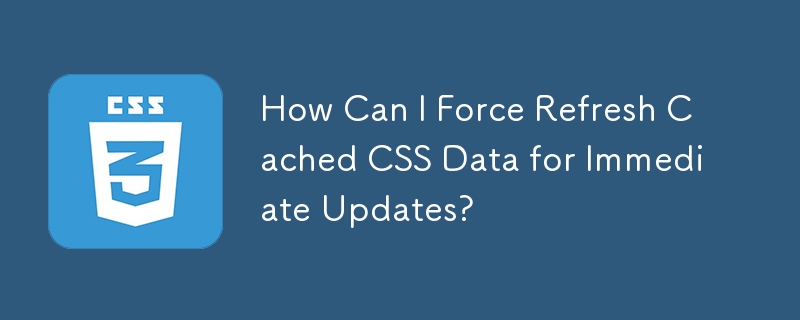How Can I Force Refresh Cached CSS Data for Immediate Updates?

Force Refreshing of Cached CSS Data
In order to ensure that new CSS changes are immediately reflected on user browsers, it is necessary to bypass cached versions of the CSS files. This article explores various approaches to accomplish this.
Understanding Caching Behavior
Before implementing force refresh strategies, it is crucial to understand how browsers handle caching. Typically, browsers cache static files with consistent filenames for extended periods. However, changes to filename or query string trigger fresh requests.
Methods to Force Refresh CSS
1. File Name or Query String Modification:
- File Name Change: Create a new version of the CSS file with a different filename. Browsers will treat a new filename as a fresh request.
- Query String Addition: Append a random query parameter (e.g., "?v=1") to the CSS URL. Browsers will consider this a new URL, triggering a fresh request.
2. Using Unique Changes Per Release:
- Build Number or Date: Embed a build number or date in the query string or filename. This ensures that requests for different releases will always be fresh.
3. HTTP Headers for Caching Optimization:
- Cache-Control: Set headers like Cache-Control: no-cache or Cache-Control: max-age=0 to avoid browser caching.
- Etag Header: Use an Etag header to inform browsers of any file changes. Browsers will compare the Etag with the cached version and fetch the new file if there is a mismatch.
Conclusion
Force refreshing cached CSS is essential for timely display of CSS updates. By understanding caching behavior and implementing the appropriate strategies outlined above, developers can overcome this challenge and ensure that user browsers always access the most current CSS version.
The above is the detailed content of How Can I Force Refresh Cached CSS Data for Immediate Updates?. For more information, please follow other related articles on the PHP Chinese website!

Hot AI Tools

Undresser.AI Undress
AI-powered app for creating realistic nude photos

AI Clothes Remover
Online AI tool for removing clothes from photos.

Undress AI Tool
Undress images for free

Clothoff.io
AI clothes remover

Video Face Swap
Swap faces in any video effortlessly with our completely free AI face swap tool!

Hot Article

Hot Tools

Notepad++7.3.1
Easy-to-use and free code editor

SublimeText3 Chinese version
Chinese version, very easy to use

Zend Studio 13.0.1
Powerful PHP integrated development environment

Dreamweaver CS6
Visual web development tools

SublimeText3 Mac version
God-level code editing software (SublimeText3)

Hot Topics
 1664
1664
 14
14
 1421
1421
 52
52
 1315
1315
 25
25
 1266
1266
 29
29
 1239
1239
 24
24
 Google Fonts Variable Fonts
Apr 09, 2025 am 10:42 AM
Google Fonts Variable Fonts
Apr 09, 2025 am 10:42 AM
I see Google Fonts rolled out a new design (Tweet). Compared to the last big redesign, this feels much more iterative. I can barely tell the difference
 How to Create an Animated Countdown Timer With HTML, CSS and JavaScript
Apr 11, 2025 am 11:29 AM
How to Create an Animated Countdown Timer With HTML, CSS and JavaScript
Apr 11, 2025 am 11:29 AM
Have you ever needed a countdown timer on a project? For something like that, it might be natural to reach for a plugin, but it’s actually a lot more
 HTML Data Attributes Guide
Apr 11, 2025 am 11:50 AM
HTML Data Attributes Guide
Apr 11, 2025 am 11:50 AM
Everything you ever wanted to know about data attributes in HTML, CSS, and JavaScript.
 A Proof of Concept for Making Sass Faster
Apr 16, 2025 am 10:38 AM
A Proof of Concept for Making Sass Faster
Apr 16, 2025 am 10:38 AM
At the start of a new project, Sass compilation happens in the blink of an eye. This feels great, especially when it’s paired with Browsersync, which reloads
 How We Created a Static Site That Generates Tartan Patterns in SVG
Apr 09, 2025 am 11:29 AM
How We Created a Static Site That Generates Tartan Patterns in SVG
Apr 09, 2025 am 11:29 AM
Tartan is a patterned cloth that’s typically associated with Scotland, particularly their fashionable kilts. On tartanify.com, we gathered over 5,000 tartan
 How to Build Vue Components in a WordPress Theme
Apr 11, 2025 am 11:03 AM
How to Build Vue Components in a WordPress Theme
Apr 11, 2025 am 11:03 AM
The inline-template directive allows us to build rich Vue components as a progressive enhancement over existing WordPress markup.
 PHP is A-OK for Templating
Apr 11, 2025 am 11:04 AM
PHP is A-OK for Templating
Apr 11, 2025 am 11:04 AM
PHP templating often gets a bad rap for facilitating subpar code — but that doesn't have to be the case. Let’s look at how PHP projects can enforce a basic
 A Comparison of Static Form Providers
Apr 16, 2025 am 11:20 AM
A Comparison of Static Form Providers
Apr 16, 2025 am 11:20 AM
Let’s attempt to coin a term here: "Static Form Provider." You bring your HTML




